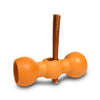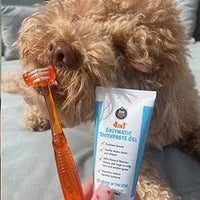Many dog parents avoid nail trimming because it can be intimidating—but letting your dog’s nails grow too long can lead to serious health issues. If you're dealing with severely overgrown nails, don't worry, this guide will walk you through how to trim them safely and help the quick recede over time.
Why Overgrown Nails Are a Problem for Dogs
Dog nails that are too long can cause a variety of problems. When a dog’s nails are overgrown and touch the ground constantly, they put pressure on the nail bed, which can cause discomfort or even pain. This can alter your dog’s posture and the way they walk, potentially leading to joint or skeletal issues over time.
Some common signs your dog’s nails are too long include:
- Clicking sounds when they walk on hard floors
- Limping or favoring one paw
- Reluctance to go on walks or climb stairs
- Splayed toes or uneven paw pads
In severe cases, nails can curl under and grow into the paw pad, leading to infection and intense pain. Regular nail care helps prevent these issues and keeps your dog comfortable and healthy.
Understanding the Quick Inside Your Dog’s Nail
Before you begin trimming, it’s essential to understand the anatomy of a dog’s nail. Inside each nail is a section called the quick, which contains nerves and blood vessels. Cutting into the quick can be painful and cause bleeding—especially in dogs with dark nails where the quick is hard to see.
The more overgrown the nail, the longer the quick tends to grow. That means you can’t simply trim the nail down to its ideal length—you’ll need to trim it gradually to avoid hitting the quick.

How to Safely Trim Severely Overgrown Dog Nails
Trimming severely overgrown dog nails requires patience, the right tools and a calm approach. Here’s a step-by-step process to help you do it safely:
Step 1: Gather Your Supplies
You’ll need:
- Dog nail clippers or a grinder
- Styptic powder (to stop bleeding in case of a nick)
- Treats or toys for positive reinforcement
- A flashlight (helpful for spotting the quick in lighter nails)
- A file or Dremel for smoothing edges
Step 2: Get Your Dog Comfortable
Pick a quiet space and help your dog feel relaxed. You can sit beside or behind them, depending on what works best for their comfort. If your dog is anxious, try trimming one or two nails at a time and work up gradually.
Step 3: Identify the Quick
For dogs with light-colored nails, you may be able to see the pinkish quick inside. For dark nails, look for a chalky white ring around a darker center—that's your cue to stop cutting.
Step 4: Start Small
Trim just the tip of each nail—only a sliver at a time. You might not see much progress in the first session, and that’s okay. The goal is to avoid cutting the quick and start training it to recede with regular trims.
Step 5: Take Breaks and Use Rewards
Praise your dog after each nail and offer treats. This helps build positive associations with the process and makes future sessions easier.
How to Cut Your Dog’s Nails to Help the Quick Recede
When you trim nails a little at a time, the quick will naturally start to recede. This process can take several weeks or even months, depending on how long the nails were when you started.
Here’s how to encourage the quick to recede:
- Trim every 5–7 days to maintain steady progress
- Cut only a small portion each time—avoid getting too close too fast
- Use a grinder or file after clipping to smooth the nail and gently wear it down
- Continue to reward calm behavior throughout
Eventually, the quick will shrink back, allowing you to gradually shorten the nails to a healthy length.

Tips for Nervous Dogs or First-Time Groomers
If your dog is nervous or resistant to nail trims, here are a few helpful tips:
- Walks on hard surfaces like concrete can help naturally wear down nails.
- Try a nail grinder instead of clippers—some dogs prefer the sensation.
- Desensitize your dog by touching and handling their paws regularly between trims.
- Break sessions into small chunks and gradually increase how many nails you do at once.
- Don’t be afraid to ask for help. If you're uncomfortable or your dog is very anxious, a groomer or veterinarian can guide you or handle the trimming professionally.
Consistency Is Key
Trimming overgrown dog nails doesn’t happen in one session, it’s a gradual process that requires consistency, patience and care. By trimming a little at a time and encouraging the quick to recede, you’ll improve your dog’s comfort, mobility and overall health.
A regular trimming routine is one of the simplest ways to keep your dog happy, healthy and pain-free. So, grab those clippers, take it slow and celebrate the small wins. Your dog—and their paws—will thank you.

















